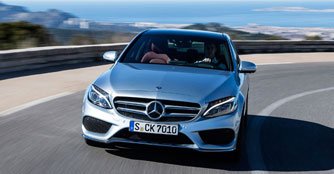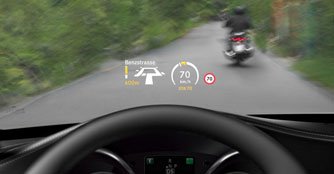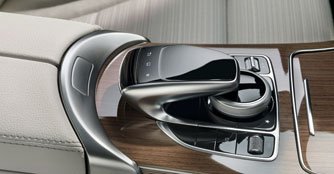Mercedes-Benz C-Class C250 (A) First Drive Review
02 May 2014|77,720 views
If what you 'C' here is what you get, you'd be driving in the lap of S-Class luxury for about half the price. Indeed, the latest C-Class looks like a stylishly shrunken scale model of Mercedes' flagship saloon, especially when viewed from the rear three-quarter angle. Besides boasting some of the S-Class' grand style, the C-Class now also offers a few top-of-the-line features worthy of, well, a flagship.
Compared to the old W204 C-Class, the new W205 is up to 100kg lighter, of which 40kg comes from the greater use of aluminium in the bodywork - 48 percent of total surface area (including the roof, doors, bonnet, front fenders and boot lid), versus nine percent for the predecessor (whose 2011 mid-life update included a bonnet made from the light metal instead of steel). By vehicle weight, aluminium now makes up 24 percent, versus just four percent for the old C.
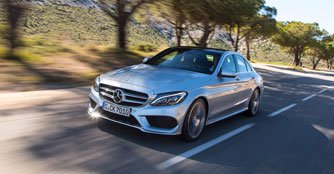
 If what you 'C' is what you get, you'd be driving in the lap of S-Class luxury for about half the price
If what you 'C' is what you get, you'd be driving in the lap of S-Class luxury for about half the price
Exterior
More obvious, of course, is the physical upsizing. The new C-Class has grown by 95mm in length and 40mm in breadth, and it sits on an 80mm-longer wheelbase with wider tracks (+41mm front, +23mm rear). With the growth in dimensions, the C is now bigger than the CLA, which is how it should be (the previous C is actually slightly shorter from bumper to bumper and narrower than its sibling based on the A-Class supermini).
Like before, there's a choice of two different nose designs: one with the tristar emblem parked prominently at the centre of a 'thrusting' grille, and the other with the tristar badge standing proudly on the bonnet, above a classic chrome-laden Mercedes grille. The traditional nose treatment, only available with the Exclusive equipment line, suits an 'uncle', whereas the sleeker facade is meant for his 'nephew'.
Compared to the old W204 C-Class, the new W205 is up to 100kg lighter, of which 40kg comes from the greater use of aluminium in the bodywork - 48 percent of total surface area (including the roof, doors, bonnet, front fenders and boot lid), versus nine percent for the predecessor (whose 2011 mid-life update included a bonnet made from the light metal instead of steel). By vehicle weight, aluminium now makes up 24 percent, versus just four percent for the old C.

Exterior
More obvious, of course, is the physical upsizing. The new C-Class has grown by 95mm in length and 40mm in breadth, and it sits on an 80mm-longer wheelbase with wider tracks (+41mm front, +23mm rear). With the growth in dimensions, the C is now bigger than the CLA, which is how it should be (the previous C is actually slightly shorter from bumper to bumper and narrower than its sibling based on the A-Class supermini).
Like before, there's a choice of two different nose designs: one with the tristar emblem parked prominently at the centre of a 'thrusting' grille, and the other with the tristar badge standing proudly on the bonnet, above a classic chrome-laden Mercedes grille. The traditional nose treatment, only available with the Exclusive equipment line, suits an 'uncle', whereas the sleeker facade is meant for his 'nephew'.
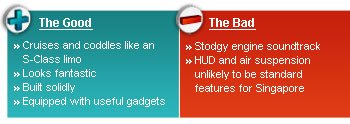 |
But both gentlemen will be equally impressed by the Airpanel, a factory option for the trad radiator grille that uses moveable shutters to regulate the frontal air flow (and resistance) according to the amount of cooling required for the engine - if the ventilation situation allows, those louvres can close the grille's 'Venetian blind' completely to help the front end cut through the air more efficiently.
The Airpanel is the most, um, dynamic part of the car's aerodynamics package, which translates into a drag coefficient (Cd) as low as 0.24, achieved by the C220 BlueTec BlueEfficiency model with aero-optimised wheels.
The previous model couldn't do better than a Cd of 0.26. Other wind cheating tricks include a smooth underbody, 'hidden' wheel arch canards, a winglet-shaped brim for the notchback, and so-called separation edges integrated with the taillight clusters.
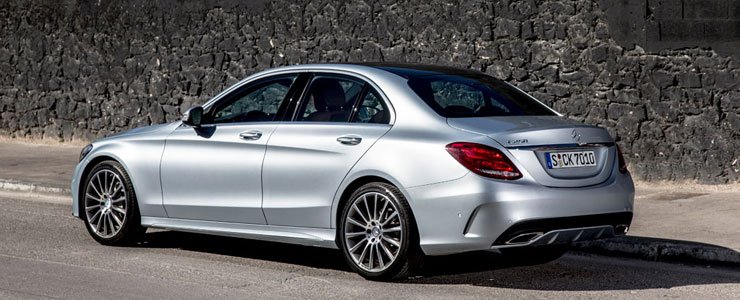 |
Interior
Seated behind the wheel and seeing the whole dashboard ensemble, the first thought that comes to my mind is, "This C is really classy". I reckon that owners of the old C-Class will think they've been upgraded from Premium Economy to Business Class - on German airline Lufthansa, of course. Even 2014 E-Class owners might feel short changed and wonder whether 'E' is positioned above 'C' or alongside.
Visibility from the driver's seat is very good, and the wiper blades are parked out of sight now (they can be seen at the bottom of the windscreen in the old model). The Mercedes designers even put three 'slashes' on each side mirror cap above its A-pillar mount, like with the S-Class, just so that it wouldn't look too blank from inside the cabin. Purely aesthetics, nothing to do with aerodynamics.

 Passengers will appreciate the new model's interior and softer seats, and the well-shaped 480 litres of space behind them
Passengers will appreciate the new model's interior and softer seats, and the well-shaped 480 litres of space behind them
The controls on the dashboard, doors and steering wheel/column follow the familiar Mercedes template, but they're shinier and tighter than those in the superseded C-Class. Not only that, the switches, stalks and door locks sound nicer when operated, and there's a rich click whenever an air-con vent is returned to its centralised position. Even the loudspeaker covers are posh, with their photo-etched structures and stainless steel borders.
Other shiok 'touches' are the steering wheel (leather-trimmed, three-spoke and with two sets of six user-friendly hot keys), the parking brake (now an electric device rather than the predecessor's clumsy foot-engaged, hand-released manual affair), and the gear selector (repositioned from the centre console to the steering column in the new C-Class, like last year's facelifted four-cylinder E-Class).
Seated behind the wheel and seeing the whole dashboard ensemble, the first thought that comes to my mind is, "This C is really classy". I reckon that owners of the old C-Class will think they've been upgraded from Premium Economy to Business Class - on German airline Lufthansa, of course. Even 2014 E-Class owners might feel short changed and wonder whether 'E' is positioned above 'C' or alongside.
Visibility from the driver's seat is very good, and the wiper blades are parked out of sight now (they can be seen at the bottom of the windscreen in the old model). The Mercedes designers even put three 'slashes' on each side mirror cap above its A-pillar mount, like with the S-Class, just so that it wouldn't look too blank from inside the cabin. Purely aesthetics, nothing to do with aerodynamics.

The controls on the dashboard, doors and steering wheel/column follow the familiar Mercedes template, but they're shinier and tighter than those in the superseded C-Class. Not only that, the switches, stalks and door locks sound nicer when operated, and there's a rich click whenever an air-con vent is returned to its centralised position. Even the loudspeaker covers are posh, with their photo-etched structures and stainless steel borders.
Other shiok 'touches' are the steering wheel (leather-trimmed, three-spoke and with two sets of six user-friendly hot keys), the parking brake (now an electric device rather than the predecessor's clumsy foot-engaged, hand-released manual affair), and the gear selector (repositioned from the centre console to the steering column in the new C-Class, like last year's facelifted four-cylinder E-Class).
There's an elegant touchpad that supplements the usual rotary knob for infotainment functions, which are presented stylishly on a 7.0-inch central monitor (8.4-inch with higher resolution and a bonded glass cover if you order the full-featured Comand system). Both the touchpad and the knob nestled below its overhang operate 'in duplicate', so the user can choose his preferred interface, but this might confuse the less tech-savvy and the indecisive.
I, for one, was twisting the knob to scroll through the menus and tapping the touchpad to 'enter', or pressing the former and finger-swiping the latter, or being all thumbs at some stage. And I was using my right, master hand in the left-hand-drive test car, so it would be even trickier for me to use my left hand to work the touchpad in the right-hand-drive C-Class bound for Singapore. Yup, the 'duplicate' interface is quite confusing for me.
But there's no confusion at all with the optional head-up display (HUD), which is simply the clearest I've ever seen, regardless of ambient light conditions. Yet it's unobtrusive, so there's no issue leaving it 'up' in my field of vision while driving.
The height of the projected/reflected image relative to the road and bonnet can also be adjusted, and it always stays sharp. Besides showing vehicle speed, posted speed limits and navigation instructions, the HUD also relays messages from the cruise control. The driver can choose what content is displayed, and enable/disable the HUD anytime.
I, for one, was twisting the knob to scroll through the menus and tapping the touchpad to 'enter', or pressing the former and finger-swiping the latter, or being all thumbs at some stage. And I was using my right, master hand in the left-hand-drive test car, so it would be even trickier for me to use my left hand to work the touchpad in the right-hand-drive C-Class bound for Singapore. Yup, the 'duplicate' interface is quite confusing for me.
But there's no confusion at all with the optional head-up display (HUD), which is simply the clearest I've ever seen, regardless of ambient light conditions. Yet it's unobtrusive, so there's no issue leaving it 'up' in my field of vision while driving.
The height of the projected/reflected image relative to the road and bonnet can also be adjusted, and it always stays sharp. Besides showing vehicle speed, posted speed limits and navigation instructions, the HUD also relays messages from the cruise control. The driver can choose what content is displayed, and enable/disable the HUD anytime.
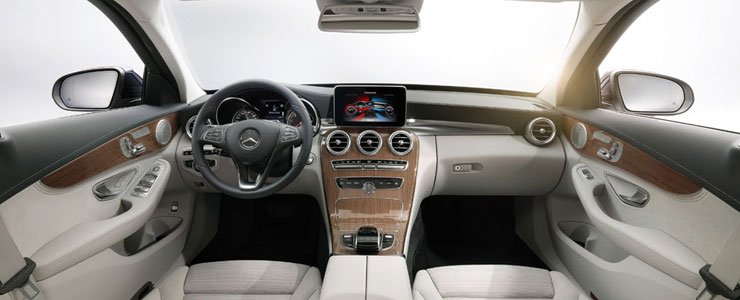 |
As clear as the HUD is the pictogram of the car depicted by the 360-degree camera system on the main screen. It looks like a real life car-toon. And this animated 'toon' can even park itself when in the real world, thanks to Parktronic with Active Parking Assist.
Yet another example of clarity in the C-Class is the crystal-clear music (and deejay jabber) played by the standard 10-speaker, 100-watt hi-fi. Pay extra for the Burmester surround sound setup and your mobile concert hall will have 14 speakers, a 9-channel amplifier and a total output of 640W (loud, in other words).
The best infotainment unit available for the C-Class is Comand Online, which boasts, well, the best mix of information and entertainment - fast Internet access, on-board Wi-Fi hotspot, DAB radio receiver, digital TV tuner, multimedia plug-in/playback, JPEG viewer, traffic data updater, 10GB hard disk, plus a good old CD/DVD drive. The unit also supports Linguatronic, Mercedes' convenient voice-operated control for the audio, telephone and navigation.
Also, the car's manual has been digitised and built into the Comand browser, so instead of a chunky 450-page handbook for the owner, there's a handy 100-page booklet that covers the essentials.
Yet another example of clarity in the C-Class is the crystal-clear music (and deejay jabber) played by the standard 10-speaker, 100-watt hi-fi. Pay extra for the Burmester surround sound setup and your mobile concert hall will have 14 speakers, a 9-channel amplifier and a total output of 640W (loud, in other words).
The best infotainment unit available for the C-Class is Comand Online, which boasts, well, the best mix of information and entertainment - fast Internet access, on-board Wi-Fi hotspot, DAB radio receiver, digital TV tuner, multimedia plug-in/playback, JPEG viewer, traffic data updater, 10GB hard disk, plus a good old CD/DVD drive. The unit also supports Linguatronic, Mercedes' convenient voice-operated control for the audio, telephone and navigation.
Also, the car's manual has been digitised and built into the Comand browser, so instead of a chunky 450-page handbook for the owner, there's a handy 100-page booklet that covers the essentials.
Finding a place to stash said booklet is not a problem, with the C-Class interior now more practical than before. For instance, the front door pockets have 3.2 litres more stowage volume each than those in the previous model (which also lacks the newcomer's rear door bins), and the pair of rear cupholders can be deployed individually (they open/close together previously).
The deployment in question is also much slicker, with none of the clatter that afflicts the older set of cupholders. Also gone are the tacky underseat compartments that tend to brush against the thighs of front occupants.
Too bad the glovebox, apparently unchanged in capacity (but with an even gentler lid-opening action), cannot store more stuff than before. It's smaller inside if you specify the Air-Balance option, whose glass flask with the refillable fragrance and integrated dispenser takes up about a quarter of the glovebox.
The 'active fragrancing' can be switched off, and its intensity altered. Four different 'Mood' aromas are offered: Freeside, Nightlife, Downtown and Sports.
The deployment in question is also much slicker, with none of the clatter that afflicts the older set of cupholders. Also gone are the tacky underseat compartments that tend to brush against the thighs of front occupants.
Too bad the glovebox, apparently unchanged in capacity (but with an even gentler lid-opening action), cannot store more stuff than before. It's smaller inside if you specify the Air-Balance option, whose glass flask with the refillable fragrance and integrated dispenser takes up about a quarter of the glovebox.
The 'active fragrancing' can be switched off, and its intensity altered. Four different 'Mood' aromas are offered: Freeside, Nightlife, Downtown and Sports.
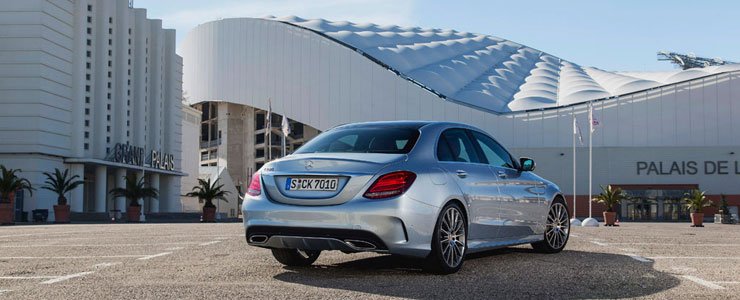 |
Drivetrain
Doing a far more convincing job of putting anyone in the mood for sports is the engine under the bonnet of the C250. Turbocharged to 211bhp and 350Nm, the four-cylinder is essentially the same rear drive, seven-speed automatic motor that powers the E250, but the C250 performs much better because it's some 200kg lighter.
The only disappointment is the boring-sounding engine. This Merc is as torquey as the VW Golf GTI and accelerates almost as vigorously, but sounds like a hardworking vacuum cleaner, albeit an upmarket one made in Germany.
The drivetrain is certainly effective, reacting promptly in Marseille's busy town traffic and responding strongly on quiet French countryside roads, accompanied by suitably slurred gearchanges. The 7G-Tronic transmission prefers to do its job smoothly rather than speedily, even when you override the computer with the paddle-shifters, but there's enough turbo torque across the rev range to make major 'gear-leaps' unnecessary.
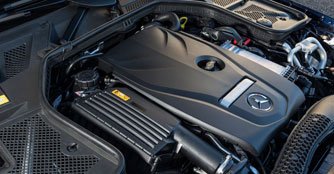
 C250's turbocharged 2.0-litre engine has plenty of horsepower and first-rate fuel efficiency, but sounds monotonous
C250's turbocharged 2.0-litre engine has plenty of horsepower and first-rate fuel efficiency, but sounds monotonous
On standby to stretch the mileage is the C-Class' Eco mode, which is more ecological than the previous model's function of the same name that is basically just auto start/stop.
The newest Eco mode has that and more - a deliberately torpid throttle pedal, reduced power usage for the air-con and rear demister, an in-dash green graphic display to track and encourage economical driving, and the ability to 'sail' (freewheel on the road using the car's kinetic energy and with the powertrain in 'neutral').
When the need for velocity overcomes the need for economy, you'll find the ride-and-handling equation to be excellent. The C250 (tested with AMG kit that comprises 15mm lower, stiffer suspension plus 225/45 R18 front and 245/50 R18 rear tyres) is less sharp than the naturally racy BMW 328i when changing direction or tackling a switchback, but it's cushier when cruising (on France's autoroutes in this case), with minimal road-and-wind noise.
Mercedes' radar-based adaptive cruise control system, Distronic Plus, makes it even easier for this car to travel at speed on the expressway for 20 to 30km at a time.
The C-Class suspension comes as standard with variable damping, Agility Select and a terrific toggle switch to pick one of the five modes - Comfort, Eco (covered earlier), Sport, Sport+ and Individual. Each mode modifies the characteristics of the throttle response, speed-sensitive power steering, transmission gearchanges and, most importantly, the dampers.
Doing a far more convincing job of putting anyone in the mood for sports is the engine under the bonnet of the C250. Turbocharged to 211bhp and 350Nm, the four-cylinder is essentially the same rear drive, seven-speed automatic motor that powers the E250, but the C250 performs much better because it's some 200kg lighter.
The only disappointment is the boring-sounding engine. This Merc is as torquey as the VW Golf GTI and accelerates almost as vigorously, but sounds like a hardworking vacuum cleaner, albeit an upmarket one made in Germany.
The drivetrain is certainly effective, reacting promptly in Marseille's busy town traffic and responding strongly on quiet French countryside roads, accompanied by suitably slurred gearchanges. The 7G-Tronic transmission prefers to do its job smoothly rather than speedily, even when you override the computer with the paddle-shifters, but there's enough turbo torque across the rev range to make major 'gear-leaps' unnecessary.

On standby to stretch the mileage is the C-Class' Eco mode, which is more ecological than the previous model's function of the same name that is basically just auto start/stop.
The newest Eco mode has that and more - a deliberately torpid throttle pedal, reduced power usage for the air-con and rear demister, an in-dash green graphic display to track and encourage economical driving, and the ability to 'sail' (freewheel on the road using the car's kinetic energy and with the powertrain in 'neutral').
When the need for velocity overcomes the need for economy, you'll find the ride-and-handling equation to be excellent. The C250 (tested with AMG kit that comprises 15mm lower, stiffer suspension plus 225/45 R18 front and 245/50 R18 rear tyres) is less sharp than the naturally racy BMW 328i when changing direction or tackling a switchback, but it's cushier when cruising (on France's autoroutes in this case), with minimal road-and-wind noise.
Mercedes' radar-based adaptive cruise control system, Distronic Plus, makes it even easier for this car to travel at speed on the expressway for 20 to 30km at a time.
The C-Class suspension comes as standard with variable damping, Agility Select and a terrific toggle switch to pick one of the five modes - Comfort, Eco (covered earlier), Sport, Sport+ and Individual. Each mode modifies the characteristics of the throttle response, speed-sensitive power steering, transmission gearchanges and, most importantly, the dampers.
'Comfort' provides the most, well, comfortable compromise, while 'Sport' makes the machine feel keener on the move and more capable in corners. 'Sport+' is the track-attack mode that also makes the steering unnecessarily heavy, which is where 'Individual' comes in - this mode can be configured via its 'Adapt' sub-menu to the driver's preference, so you can keep the steering well-assisted and easy to twirl while the suspension and powertrain are made sporty.
If the driver leaves the car and restarts it within four hours, the previously chosen Agility Select setting is reactivated. If the stop is longer than four hours, the system reverts to 'Comfort' mode.
The C-Class even offers Airmatic air suspension as an option (for a reasonable 1,100 euros in Europe), which is a first in this category. Airmatic brings electronically controlled, continuously variable (in fractions of a second) damping at the front and rear axles, all-round self-levelling for the optimum ride height always, plus extra ground clearance at the push of a button for rough roads or ridiculous ramps. Equipped with Airmatic, this saloon has an even broader motoring bandwidth - plush and calm in Comfort mode, firm and fun in Sport+.
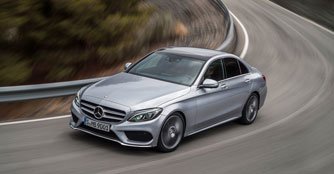
 The C250 claimed to average 18.9km/L. I only managed 13.6km/L, which is still respectable considering the energetic performance and how often I used it
The C250 claimed to average 18.9km/L. I only managed 13.6km/L, which is still respectable considering the energetic performance and how often I used it
Conclusion
It's a modern Mercedes, so the C-Class comes with a reassuring array of safety features. In addition to multiple airbags that cushion the occupants in an accident, there are advanced driving aids that try to prevent accidents in the first place, such as Collision Prevention Assist Plus, Active Lane Keeping Assist, Active Blind Spot Assist, Pre-Safe Brake, Steer Control and Crosswind Assist.
The automaker groups all its clever safety systems under Intelligent Drive, which is so safety-conscious that the driver has to be pretty unintelligent to get into a crash anyway.
Aged towkays and new-age technopreneurs alike would feel relaxed inside this compact, classy and comfortable Mercedes saloon. The latest C-Class will be introduced to Singapore in the third quarter of this year, when you can 'C' the class and sense the comfort for yourself.
If the driver leaves the car and restarts it within four hours, the previously chosen Agility Select setting is reactivated. If the stop is longer than four hours, the system reverts to 'Comfort' mode.
The C-Class even offers Airmatic air suspension as an option (for a reasonable 1,100 euros in Europe), which is a first in this category. Airmatic brings electronically controlled, continuously variable (in fractions of a second) damping at the front and rear axles, all-round self-levelling for the optimum ride height always, plus extra ground clearance at the push of a button for rough roads or ridiculous ramps. Equipped with Airmatic, this saloon has an even broader motoring bandwidth - plush and calm in Comfort mode, firm and fun in Sport+.

Conclusion
It's a modern Mercedes, so the C-Class comes with a reassuring array of safety features. In addition to multiple airbags that cushion the occupants in an accident, there are advanced driving aids that try to prevent accidents in the first place, such as Collision Prevention Assist Plus, Active Lane Keeping Assist, Active Blind Spot Assist, Pre-Safe Brake, Steer Control and Crosswind Assist.
The automaker groups all its clever safety systems under Intelligent Drive, which is so safety-conscious that the driver has to be pretty unintelligent to get into a crash anyway.
Aged towkays and new-age technopreneurs alike would feel relaxed inside this compact, classy and comfortable Mercedes saloon. The latest C-Class will be introduced to Singapore in the third quarter of this year, when you can 'C' the class and sense the comfort for yourself.
If what you 'C' here is what you get, you'd be driving in the lap of S-Class luxury for about half the price. Indeed, the latest C-Class looks like a stylishly shrunken scale model of Mercedes' flagship saloon, especially when viewed from the rear three-quarter angle. Besides boasting some of the S-Class' grand style, the C-Class now also offers a few top-of-the-line features worthy of, well, a flagship.
Compared to the old W204 C-Class, the new W205 is up to 100kg lighter, of which 40kg comes from the greater use of aluminium in the bodywork - 48 percent of total surface area (including the roof, doors, bonnet, front fenders and boot lid), versus nine percent for the predecessor (whose 2011 mid-life update included a bonnet made from the light metal instead of steel). By vehicle weight, aluminium now makes up 24 percent, versus just four percent for the old C.
Exterior
More obvious, of course, is the physical upsizing. The new C-Class has grown by 95mm in length and 40mm in breadth, and it sits on an 80mm-longer wheelbase with wider tracks (+41mm front, +23mm rear). With the growth in dimensions, the C is now bigger than the CLA, which is how it should be (the previous C is actually slightly shorter from bumper to bumper and narrower than its sibling based on the A-Class supermini).
Like before, there's a choice of two different nose designs: one with the tristar emblem parked prominently at the centre of a 'thrusting' grille, and the other with the tristar badge standing proudly on the bonnet, above a classic chrome-laden Mercedes grille. The traditional nose treatment, only available with the Exclusive equipment line, suits an 'uncle', whereas the sleeker facade is meant for his 'nephew'.
Compared to the old W204 C-Class, the new W205 is up to 100kg lighter, of which 40kg comes from the greater use of aluminium in the bodywork - 48 percent of total surface area (including the roof, doors, bonnet, front fenders and boot lid), versus nine percent for the predecessor (whose 2011 mid-life update included a bonnet made from the light metal instead of steel). By vehicle weight, aluminium now makes up 24 percent, versus just four percent for the old C.
Exterior
More obvious, of course, is the physical upsizing. The new C-Class has grown by 95mm in length and 40mm in breadth, and it sits on an 80mm-longer wheelbase with wider tracks (+41mm front, +23mm rear). With the growth in dimensions, the C is now bigger than the CLA, which is how it should be (the previous C is actually slightly shorter from bumper to bumper and narrower than its sibling based on the A-Class supermini).
Like before, there's a choice of two different nose designs: one with the tristar emblem parked prominently at the centre of a 'thrusting' grille, and the other with the tristar badge standing proudly on the bonnet, above a classic chrome-laden Mercedes grille. The traditional nose treatment, only available with the Exclusive equipment line, suits an 'uncle', whereas the sleeker facade is meant for his 'nephew'.
But both gentlemen will be equally impressed by the Airpanel, a factory option for the trad radiator grille that uses moveable shutters to regulate the frontal air flow (and resistance) according to the amount of cooling required for the engine - if the ventilation situation allows, those louvres can close the grille's 'Venetian blind' completely to help the front end cut through the air more efficiently.
The Airpanel is the most, um, dynamic part of the car's aerodynamics package, which translates into a drag coefficient (Cd) as low as 0.24, achieved by the C220 BlueTec BlueEfficiency model with aero-optimised wheels.
The previous model couldn't do better than a Cd of 0.26. Other wind cheating tricks include a smooth underbody, 'hidden' wheel arch canards, a winglet-shaped brim for the notchback, and so-called separation edges integrated with the taillight clusters.
The Airpanel is the most, um, dynamic part of the car's aerodynamics package, which translates into a drag coefficient (Cd) as low as 0.24, achieved by the C220 BlueTec BlueEfficiency model with aero-optimised wheels.
The previous model couldn't do better than a Cd of 0.26. Other wind cheating tricks include a smooth underbody, 'hidden' wheel arch canards, a winglet-shaped brim for the notchback, and so-called separation edges integrated with the taillight clusters.
Interior
Seated behind the wheel and seeing the whole dashboard ensemble, the first thought that comes to my mind is, "This C is really classy". I reckon that owners of the old C-Class will think they've been upgraded from Premium Economy to Business Class - on German airline Lufthansa, of course. Even 2014 E-Class owners might feel short changed and wonder whether 'E' is positioned above 'C' or alongside.
Visibility from the driver's seat is very good, and the wiper blades are parked out of sight now (they can be seen at the bottom of the windscreen in the old model). The Mercedes designers even put three 'slashes' on each side mirror cap above its A-pillar mount, like with the S-Class, just so that it wouldn't look too blank from inside the cabin. Purely aesthetics, nothing to do with aerodynamics.
The controls on the dashboard, doors and steering wheel/column follow the familiar Mercedes template, but they're shinier and tighter than those in the superseded C-Class. Not only that, the switches, stalks and door locks sound nicer when operated, and there's a rich click whenever an air-con vent is returned to its centralised position. Even the loudspeaker covers are posh, with their photo-etched structures and stainless steel borders.
Other shiok 'touches' are the steering wheel (leather-trimmed, three-spoke and with two sets of six user-friendly hot keys), the parking brake (now an electric device rather than the predecessor's clumsy foot-engaged, hand-released manual affair), and the gear selector (repositioned from the centre console to the steering column in the new C-Class, like last year's facelifted four-cylinder E-Class).
There's an elegant touchpad that supplements the usual rotary knob for infotainment functions, which are presented stylishly on a 7.0-inch central monitor (8.4-inch with higher resolution and a bonded glass cover if you order the full-featured Comand system). Both the touchpad and the knob nestled below its overhang operate 'in duplicate', so the user can choose his preferred interface, but this might confuse the less tech-savvy and the indecisive.
I, for one, was twisting the knob to scroll through the menus and tapping the touchpad to 'enter', or pressing the former and finger-swiping the latter, or being all thumbs at some stage. And I was using my right, master hand in the left-hand-drive test car, so it would be even trickier for me to use my left hand to work the touchpad in the right-hand-drive C-Class bound for Singapore. Yup, the 'duplicate' interface is quite confusing for me.
But there's no confusion at all with the optional head-up display (HUD), which is simply the clearest I've ever seen, regardless of ambient light conditions. Yet it's unobtrusive, so there's no issue leaving it 'up' in my field of vision while driving.
The height of the projected/reflected image relative to the road and bonnet can also be adjusted, and it always stays sharp. Besides showing vehicle speed, posted speed limits and navigation instructions, the HUD also relays messages from the cruise control. The driver can choose what content is displayed, and enable/disable the HUD anytime.
I, for one, was twisting the knob to scroll through the menus and tapping the touchpad to 'enter', or pressing the former and finger-swiping the latter, or being all thumbs at some stage. And I was using my right, master hand in the left-hand-drive test car, so it would be even trickier for me to use my left hand to work the touchpad in the right-hand-drive C-Class bound for Singapore. Yup, the 'duplicate' interface is quite confusing for me.
But there's no confusion at all with the optional head-up display (HUD), which is simply the clearest I've ever seen, regardless of ambient light conditions. Yet it's unobtrusive, so there's no issue leaving it 'up' in my field of vision while driving.
The height of the projected/reflected image relative to the road and bonnet can also be adjusted, and it always stays sharp. Besides showing vehicle speed, posted speed limits and navigation instructions, the HUD also relays messages from the cruise control. The driver can choose what content is displayed, and enable/disable the HUD anytime.
As clear as the HUD is the pictogram of the car depicted by the 360-degree camera system on the main screen. It looks like a real life car-toon. And this animated 'toon' can even park itself when in the real world, thanks to Parktronic with Active Parking Assist.
Yet another example of clarity in the C-Class is the crystal-clear music (and deejay jabber) played by the standard 10-speaker, 100-watt hi-fi. Pay extra for the Burmester surround sound setup and your mobile concert hall will have 14 speakers, a 9-channel amplifier and a total output of 640W (loud, in other words).
The best infotainment unit available for the C-Class is Comand Online, which boasts, well, the best mix of information and entertainment - fast Internet access, on-board Wi-Fi hotspot, DAB radio receiver, digital TV tuner, multimedia plug-in/playback, JPEG viewer, traffic data updater, 10GB hard disk, plus a good old CD/DVD drive. The unit also supports Linguatronic, Mercedes' convenient voice-operated control for the audio, telephone and navigation.
Also, the car's manual has been digitised and built into the Comand browser, so instead of a chunky 450-page handbook for the owner, there's a handy 100-page booklet that covers the essentials.
Yet another example of clarity in the C-Class is the crystal-clear music (and deejay jabber) played by the standard 10-speaker, 100-watt hi-fi. Pay extra for the Burmester surround sound setup and your mobile concert hall will have 14 speakers, a 9-channel amplifier and a total output of 640W (loud, in other words).
The best infotainment unit available for the C-Class is Comand Online, which boasts, well, the best mix of information and entertainment - fast Internet access, on-board Wi-Fi hotspot, DAB radio receiver, digital TV tuner, multimedia plug-in/playback, JPEG viewer, traffic data updater, 10GB hard disk, plus a good old CD/DVD drive. The unit also supports Linguatronic, Mercedes' convenient voice-operated control for the audio, telephone and navigation.
Also, the car's manual has been digitised and built into the Comand browser, so instead of a chunky 450-page handbook for the owner, there's a handy 100-page booklet that covers the essentials.
Finding a place to stash said booklet is not a problem, with the C-Class interior now more practical than before. For instance, the front door pockets have 3.2 litres more stowage volume each than those in the previous model (which also lacks the newcomer's rear door bins), and the pair of rear cupholders can be deployed individually (they open/close together previously).
The deployment in question is also much slicker, with none of the clatter that afflicts the older set of cupholders. Also gone are the tacky underseat compartments that tend to brush against the thighs of front occupants.
Too bad the glovebox, apparently unchanged in capacity (but with an even gentler lid-opening action), cannot store more stuff than before. It's smaller inside if you specify the Air-Balance option, whose glass flask with the refillable fragrance and integrated dispenser takes up about a quarter of the glovebox.
The 'active fragrancing' can be switched off, and its intensity altered. Four different 'Mood' aromas are offered: Freeside, Nightlife, Downtown and Sports.
The deployment in question is also much slicker, with none of the clatter that afflicts the older set of cupholders. Also gone are the tacky underseat compartments that tend to brush against the thighs of front occupants.
Too bad the glovebox, apparently unchanged in capacity (but with an even gentler lid-opening action), cannot store more stuff than before. It's smaller inside if you specify the Air-Balance option, whose glass flask with the refillable fragrance and integrated dispenser takes up about a quarter of the glovebox.
The 'active fragrancing' can be switched off, and its intensity altered. Four different 'Mood' aromas are offered: Freeside, Nightlife, Downtown and Sports.
Drivetrain
Doing a far more convincing job of putting anyone in the mood for sports is the engine under the bonnet of the C250. Turbocharged to 211bhp and 350Nm, the four-cylinder is essentially the same rear drive, seven-speed automatic motor that powers the E250, but the C250 performs much better because it's some 200kg lighter.
The only disappointment is the boring-sounding engine. This Merc is as torquey as the VW Golf GTI and accelerates almost as vigorously, but sounds like a hardworking vacuum cleaner, albeit an upmarket one made in Germany.
The drivetrain is certainly effective, reacting promptly in Marseille's busy town traffic and responding strongly on quiet French countryside roads, accompanied by suitably slurred gearchanges. The 7G-Tronic transmission prefers to do its job smoothly rather than speedily, even when you override the computer with the paddle-shifters, but there's enough turbo torque across the rev range to make major 'gear-leaps' unnecessary.
On standby to stretch the mileage is the C-Class' Eco mode, which is more ecological than the previous model's function of the same name that is basically just auto start/stop.
The newest Eco mode has that and more - a deliberately torpid throttle pedal, reduced power usage for the air-con and rear demister, an in-dash green graphic display to track and encourage economical driving, and the ability to 'sail' (freewheel on the road using the car's kinetic energy and with the powertrain in 'neutral').
When the need for velocity overcomes the need for economy, you'll find the ride-and-handling equation to be excellent. The C250 (tested with AMG kit that comprises 15mm lower, stiffer suspension plus 225/45 R18 front and 245/50 R18 rear tyres) is less sharp than the naturally racy BMW 328i when changing direction or tackling a switchback, but it's cushier when cruising (on France's autoroutes in this case), with minimal road-and-wind noise.
Mercedes' radar-based adaptive cruise control system, Distronic Plus, makes it even easier for this car to travel at speed on the expressway for 20 to 30km at a time.
The C-Class suspension comes as standard with variable damping, Agility Select and a terrific toggle switch to pick one of the five modes - Comfort, Eco (covered earlier), Sport, Sport+ and Individual. Each mode modifies the characteristics of the throttle response, speed-sensitive power steering, transmission gearchanges and, most importantly, the dampers.
'Comfort' provides the most, well, comfortable compromise, while 'Sport' makes the machine feel keener on the move and more capable in corners. 'Sport+' is the track-attack mode that also makes the steering unnecessarily heavy, which is where 'Individual' comes in - this mode can be configured via its 'Adapt' sub-menu to the driver's preference, so you can keep the steering well-assisted and easy to twirl while the suspension and powertrain are made sporty.
If the driver leaves the car and restarts it within four hours, the previously chosen Agility Select setting is reactivated. If the stop is longer than four hours, the system reverts to 'Comfort' mode.
The C-Class even offers Airmatic air suspension as an option (for a reasonable 1,100 euros in Europe), which is a first in this category. Airmatic brings electronically controlled, continuously variable (in fractions of a second) damping at the front and rear axles, all-round self-levelling for the optimum ride height always, plus extra ground clearance at the push of a button for rough roads or ridiculous ramps. Equipped with Airmatic, this saloon has an even broader motoring bandwidth - plush and calm in Comfort mode, firm and fun in Sport+.
Conclusion
It's a modern Mercedes, so the C-Class comes with a reassuring array of safety features. In addition to multiple airbags that cushion the occupants in an accident, there are advanced driving aids that try to prevent accidents in the first place, such as Collision Prevention Assist Plus, Active Lane Keeping Assist, Active Blind Spot Assist, Pre-Safe Brake, Steer Control and Crosswind Assist.
The automaker groups all its clever safety systems under Intelligent Drive, which is so safety-conscious that the driver has to be pretty unintelligent to get into a crash anyway.
Aged towkays and new-age technopreneurs alike would feel relaxed inside this compact, classy and comfortable Mercedes saloon. The latest C-Class will be introduced to Singapore in the third quarter of this year, when you can 'C' the class and sense the comfort for yourself.
If the driver leaves the car and restarts it within four hours, the previously chosen Agility Select setting is reactivated. If the stop is longer than four hours, the system reverts to 'Comfort' mode.
The C-Class even offers Airmatic air suspension as an option (for a reasonable 1,100 euros in Europe), which is a first in this category. Airmatic brings electronically controlled, continuously variable (in fractions of a second) damping at the front and rear axles, all-round self-levelling for the optimum ride height always, plus extra ground clearance at the push of a button for rough roads or ridiculous ramps. Equipped with Airmatic, this saloon has an even broader motoring bandwidth - plush and calm in Comfort mode, firm and fun in Sport+.
Conclusion
It's a modern Mercedes, so the C-Class comes with a reassuring array of safety features. In addition to multiple airbags that cushion the occupants in an accident, there are advanced driving aids that try to prevent accidents in the first place, such as Collision Prevention Assist Plus, Active Lane Keeping Assist, Active Blind Spot Assist, Pre-Safe Brake, Steer Control and Crosswind Assist.
The automaker groups all its clever safety systems under Intelligent Drive, which is so safety-conscious that the driver has to be pretty unintelligent to get into a crash anyway.
Aged towkays and new-age technopreneurs alike would feel relaxed inside this compact, classy and comfortable Mercedes saloon. The latest C-Class will be introduced to Singapore in the third quarter of this year, when you can 'C' the class and sense the comfort for yourself.
Thank You For Your Subscription.


















